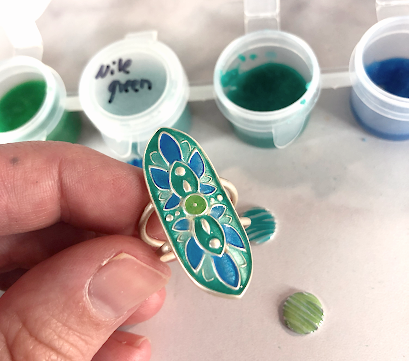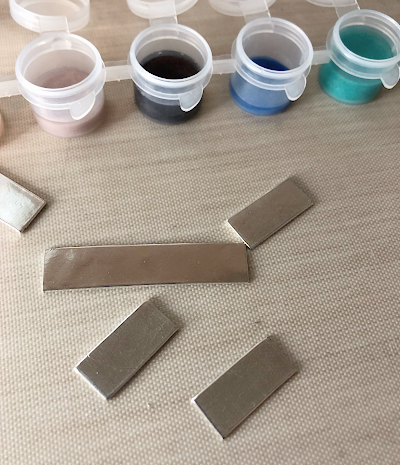
These experiments were brought on by a conversation I had with Cindy Pope at the Enamelist Conference back in 2019. Having met at the Cool Tools studio prior to the conference, she and I were discussing enameling on our common ground- metal clay. She offhandedly asked if I enamel on our EZ960 Sterling Silver Clay, and I immediately thought “Of course not, it’s sterling.” My thought process followed the line of traditional enameling, as I had learned it as a metalsmith- unless you want to go through the process of depletion gilding, or worse yet, nitric acid treating the sterling, enameling on it could result in little black dots created by trapped oxidation or fire scale or a muddying of the colors as a result of the oxide forming underneath colored transparent enamels. Then I thought of how darkened .925 sterling is after it’s been heated with a torch for soldering or annealing. While our .960 alloy comes out the kiln not the pure white that fine silver does, it certainly doesn’t take on the black cast that oxidized .925 sterling silver has. I thought of how the silver enriched content of the .960 alloy was designed to eliminate the need for carbon to prevent the formation of oxides that would typically prevent the metal clay from sintering properly, and found myself wondering if there wasn’t enough oxidation produced to inhibit sintering, then would there be enough oxidation produced to compromise the quality of enamel. Cindy, a step ahead of me, asked that shouldn’t the .960 alloy and the higher fine silver content present in enriched sterling silvers make a difference, and suggested someone should test it out to see. I wholeheartedly agreed, and decided that I was going to add it to my to-do list. While this idea fell to the back burner, I happily took on the opportunity to test this out this summer and was so pleased by the results.

In these tests, I wanted to test out transparent enamels directly onto the sintered EZ960. While beneficial in some cases, such as prior to adding reds, oranges, or other colors that do not fire well directly upon silver, I find that the use of flux prior to transparents overtop silver can lessen the beautiful luminosity quality that transparent enamels have when placed overtop silver directly. The colors don’t usually seem quite as clear and brilliant, which is another reason why individuals typically choose depletion gilding sterling silver as opposed to applying a flux layer to absorb the oxide and seal the enamel surface against oxidation in consecutive firings.

I followed the typical procedure for preparing my metal and transparent enamel. My EZ960 was fired to 1675°F with a 2 hour hold to assure it is fully sintered, and was tumbled to a polish. I then cleaned it with surfactant to remove any oil or contaminants, and washed my enamel to remove the smaller, more cloudy enamel particles. My enamel was wet, and while I could have easily dried it by placing the washed enamel in little aluminum foil folded packets on top of the kiln, I choose to just wet pack the enamel onto the silver instead of drying and sifting my washed enamel. For the first round of samples I made, I worked with four colors that I’ve used often on silver as I knew they fired well on fine silver directly and what could be expected.

I used Nitric Blue, Manganese Purple, Peppermint Green, and Gem Green. Once I wet packed my enamel, I allowed it to dry before firing it to fuse the enamel. I usually fire my Thompson Unleaded Enamels somewhere between 1400°F-1450°F, and for these colors chose to set my kiln to 1400°F. I fired the pieces until the enamel glossed out from orange peel, and excitedly waited for them to cool so I could see the surface and purity of the colors. I was thrilled to see that there were not any black dots or darkening of the colors that could be expected when enameling with transparents directly on top of sterling silver. While I thought that the colors looked pure, I wanted to create a control group of the same colors on fine silver to compare the .960 samples against. I created some strips using FS999 and treated them just as I had the EZ960. I will say that when examining the FS999 samples next to the EZ960 samples, there is a slightly more luminous quality to the enamel on the FS999 only distinguishable under bright lighting. I’m assuming a result of the silver staying a more pure white while heated when the enamel was fused, but even still, I was quite pleased with the results of the transparent enamels overtop EZ960.
I wanted to test out some more colors, just to lend support to my claim that enamels do fire well on fired .960 clay, and created some more samples. Just as with fine silver, there were some colors like Mikado Orange that did not fire well directly on the sterling and would require a flux for silver prior to the transparent enamel. I tested some more of my typical fine silver favorites: Charteuse, Rose Purple, Avocado Green, Spring Green, Nile Green, Sea Green, Nile Green, Sea Green, Water Blue and Bonnet Blue and was again pleased with the clarity of the enamel.

What excites me most about the ability to enamel on this enriched sterling is the opportunity it presents for creating more delicate enameled pieces. I would never create a ring with a thin band in fine silver, but have so often wished I could enamel rings without bulky bands. While it is true that I could use eutectic solder for enameling to apply a sterling band to a fine silver component prior to applying the enamel, some colors react nastily to the solder, and I’ve had pieces where they were in the kiln a touch too long to fuse the enamel and my solder ended up flashing, ruining the connection. If I can avoid soldering on a piece that I intend to enamel, I’ll take it! On several occasions I have created, and worn for long periods of times to test the durability, rings with thin bands created with EZ960 and am confident that I can create rings with enamel focal points and delicate bands by enameling on this enriched sterling clay. I set out to test this process in these two rings and was again very pleased with the results. The enamel is protected by being in the low areas of these sterling designs that were created by using Pattern Sheets: Metamorphosis Collection Set Five and Six from Wanaree Tanner’s signature collection and is less prone to breaking upon impact than it would be if it was not surrounded by a metal edge. So many of her patterns have elements that would be perfect for this type of project, and I’m excited to make more rings with delicate bands that have luminous pops of color from enamel. Many thanks to Cindy Pope for asking the questions that led to these little experiments.


This is so exciting! What a wonderful discovery! I look forward to trying this out once the Christmas rush passes! Thanks Karen (and Cindy) for taking the time to figure this out!
I was pleaded to learn of your research and testing enamelling
on EZ960 and will be using the knowledge in teaching PMC
jewellery making.
Boyd Parry
Artisan Silver